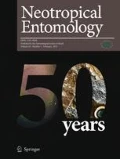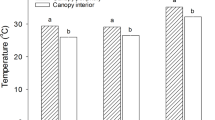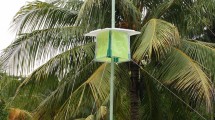Abstract
The weevil Conotrachelus dubiae O’Brien & Couturier (Coleoptera: Curculionidae) is a pest of an economically important Amazonian fruit tree Myrciaria dubia (Myrtaceae). This tree grows in seasonally flooded environments, and how weevil larvae survive flooding has not been studied. From December 2004 to May 2009, five experiments were conducted in natural conditions and in the laboratory, with the aim of understanding the mechanisms that allow the survival of C. dubiae larvae in seasonal floods in Amazonia. The larvae of C. dubiae were kept under water for over 93 days. Older instars exposed to periodic circulation of water survived better than younger instars in addition to all larvae that were kept continuously under uncirculated water. Individuals that were collected from plots of M. dubia located in flooded soils and non-flooded soils did not exhibit statistically significant differences in their levels of survival indicating that the variation in survival of flooding events is due to phenotypic plasticity of the species and not to local adaptation by the populations in different environments. We speculate that larvae can survive floods without major physiological changes as larvae appear to obtain oxygen from water by cutaneous diffusion, assisted by caudal movements.

Similar content being viewed by others
References
Adis J (1986) An “aquatic” millipede from a Central Amazonian inundation forest. Oecologia 68:347–349
Adis J (1992) How to survive six months in a flooded soil: strategies in Chilopoda and Symphyla from Central Amazonian floodplains, pp. 117–129. In: Adis J, Tanaka S (eds) Symposium on life history traits in tropical invertebrates, Yokohama. Stud Neotrop Fauna E. 27 (2–3)
Adis J (1997) Estratégias de sobrevivência de invertebrados terrestres em florestas inundáveis da amazônia central. Uma resposta à inundação de longo período. Acta Amazon 27:43–54
Adis J, Junk WJ (2002) Terrestrial invertebrates inhabiting lowland river floodplains of Central Amazonia and central Europe: a review. Freshw Biol 47:711–731
Adis J, Messner B (1991) Langzeit–Überflutungsresistenz als Überlebensstrategie bei terrestrischen Arthropoden.–Beispiele aus zentralamazonnischen Überschwemmungsgebieten. Deut Entomol Z 38:211–223
Bachmann L, Tomiuk J, Adis J, Wohland K (1998) Genetic differentiation of the millipede Pycnotropis epiclysmus inhabiting seasonally inundated and non-flooded Amazonian forests. J Zool Syst Evol Res 36:65–70
Delgado C, Couturier G (2000) The insect pests of Myrciaria dubia (Myrtaceae): a review. XXI International Congress of Entomology, Brazil, Foz de Iguassu, August 20–26, abstract book, 123 p
Delgado C, Couturier G (2004) Manejo de insectos plagas en la Amazonía: su aplicación en camu-camu. IIAP/IRD Lima, 143 p
Franklin EN, Guimaraes RL, Adis J, Schubart HOR (2001) Resistencia a submersão de acaros (Acari: Oribatida) terrestres de florestas inundaveis e de terra firme na amazônia central em condições experimentais de laboratorio. Acta Amazon 31:285–298
Hoback WW, Stanley DW (2001) Insects in hypoxia. J Insect Physiol 47:533–542
Hoback WW, Stanley DW, Higley LG, Barnhart MC (1998) Survival of immersion and anoxia by larval tiger beetles, Cicindela togata. Am Midl Nat 140:27–33
Hochachka PW (1980) Living without oxygen. Harvard University Press, Cambridge
Hoffman RL (1985) A new millipede of the genus Gonographis from an inundation forest near Manaus, Brazil (Pyrgodesmidae). Amazoniana 9:243–246
Inga H, Pinedo M, Delgado C, Linares C, Mejia K (2001) Fenología reproductiva de Myrciaria dubia Mc Vaugh (H.B.K.) camu camu. Fol Amazon 12:99–106
Junk WJ, Soares GM, Carvalho FM (1983) Distribution of fish species in a lake of the Amazon river floodplain Manaus (Lago Camaleão), with special reference to extreme oxygen conditions. Amazoniana 7:397–431
Junk WJ, Bayley PB, Sparks RE (1989) The flood pulse concept in river-floodplain systems. Can Spec Publ Fish Aquat Sci 106:110–127
Maitland DP, Maitland A (1994) Significance of burrow-opening diameter as a flood prevention mechanism for air-filled burrows of small intertidal arthropods. Mar Biol 119:221–225
Maués MM, Couturier G (2002) Biología floral e fenología reproductiva do camu-camu (Myrciaria dubia (H.B.K.) McVaugh, Myrtaceae) no Estado Pará, Brasil. Rev Bras Bot 25:441–448
O’Brien CW, Couturier G (1995) Two new agricultural pest species of Conotrachelus (Coleoptera: Curculionidae: Molytinae) in South America. Ann Soc Entomol Fr 31:227–235
Penn JW Jr (2006) The cultivation of camu camu (Myrciaria dubia): a tree planting programme in the Peruvian amazon. For Trees Livelihoods 16:85–101
Perez D, Innacone J (2008) Ciclo biológico, comportamiento y censo del picudo del camu camu, Conotrachelus dubiae O'Brien 1995 (Coleoptera: Curculionidae) en Pucallpa, Perú. Acta Amazon 38:145–152
Peters CM, Vásquez A (1987) Estudios ecológicos de camu camu (Myrciaria dubia). Producción de frutos en poblaciones naturales. Acta Amazon 16(17):161–174
Plum N (2005) Terrestrial invertebrates in flooded grassland: a literature review. Wetlands 25:721–737
Rodrigues RB, de Menezes HC, Cabral LMC, Dornier M, Reynes M (2001) An Amazonian fruit with high potential as a natural source of vitamin C: the camu-camu (Myrciaria dubia). Fruits 56:345–354
West-Eberhard MJ (1989) Phenotypic plasticity and the origins of diversity. Annu Rev Ecol Syst 20:249–278
Zerm M, Adis J, Paarmann W, Amorim MA, Fonseca CRV (2001) On habitat specificity, life cycles, and guild structure in tiger beetles of Central Amazonia (Brazil) (Coleoptera: Cicindelidae). Entomol Genet 25:141–154
Zulka KP (1996) Submersion tolerance of some Diplopod species. In: Geoffroy JJ, Mauriès JP, Nguyen Duy–Jacquemin M (eds) Acta Myriapodologica. Mém Mus natl Hist Nat 169: 477–481
Acknowledgments
We are very grateful to Laurence Goury (Direction de l’Information et de la Communication/Institut de recherche pour le développement, France) for his help to provide manuscripts and other information related to this research, to Jerónimo Vega and Marllori Vela for their work in the laboratory, and finally to Mario Irarua and Sapuena community farmers for their assistance in the fieldwork. This research was developed in the Biodiversity Program of Instituto de Investigaciones de la Amazonía Peruana and supported by the INCAGRO-MINAG fund.
Author information
Authors and Affiliations
Corresponding author
Additional information
Edited by Jorge B Torres – UFRPE
Rights and permissions
About this article
Cite this article
Delgado, C., Couturier, G. & Fine, P.V.A. Survival of Seasonal Flooding in the Amazon by the Terrestrial Insect Conotrachelus dubiae O’Brien & Couturier (Coleoptera: Curculionidae), a Pest of the Camu-Camu Plant, Myrciaria dubia (Myrtaceae). Neotrop Entomol 43, 380–384 (2014). https://doi.org/10.1007/s13744-014-0207-z
Received:
Accepted:
Published:
Issue Date:
DOI: https://doi.org/10.1007/s13744-014-0207-z




